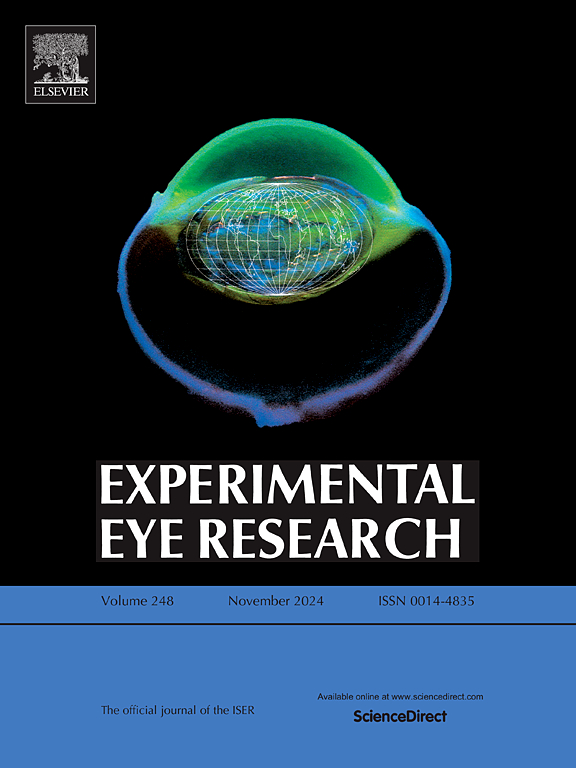Spatial heterogeneity of corneal biomechanical properties in myopia at nanoscale: A preliminary study
IF 3
2区 医学
Q1 OPHTHALMOLOGY
引用次数: 0
Abstract
Purpose
To investigate the spatial heterogeneity of the corneal biomechanical properties in individuals with non-high and high myopia.
Methods
Atomic force microscopy was used to quantify the region-dependent elastic modulus (E) of 34 corneal lenticules from keratorefractive lenticule extraction surgery. The local E values of the central region, as well as the superior, inferior, nasal, and temporal points at the pericentral region, were measured. Differences between non-high myopia (−6.0 D < spherical equivalent [SE] ≤ −0.5 D) and high myopia (SE ≤ −6.0 D) were compared.
Results
E was significantly higher in the non-high myopia group than in the high myopia group (P < 0.0001). In non-high myopia, the central cornea exhibited a higher E than its pericentral counterpart (P < 0.0001), and the pericentral region E was higher in the horizontal direction than in the vertical direction (P = 0.0393). However, these values converged to be similar in high myopia (P = 0.5973, P = 0.7799). No significant differences in E were found between the superior and inferior pericentral corneas, nor between the nasal and temporal in both non-high (P = 0.0931, P = 0.1800) and high myopia (P = 0.5154, P = 0.1007). The E values of central and pericentral cornea were positively correlated with the mean radius of the posterior corneal surface (r = 0.3747, P = 0.0290; r = 0.3961, P = 0.0204).
Conclusion
In non-high myopia, region-dependent corneal biomechanics revealed higher stiffness centrally than pericentrally, with pericentral cornea stiffer horizontally than vertically. High myopia exhibited a reduced E and a gradual loss of spatial heterogeneity. Emphasizing spatial heterogeneity is crucial for a comprehensive understanding of the biomechanical behavior in myopia.
纳米尺度近视角膜生物力学特性空间异质性的初步研究
目的探讨非高度和高度近视人群角膜生物力学特性的空间异质性。方法应用原子力显微镜对34例角膜屈光性晶状体摘除术后角膜晶状体的区域相关弹性模量(E)进行定量分析。测量中心区域的局部E值,以及中心周围区域的上、下、鼻和颞点。非高度近视(- 6.0 D <;球面等效度[SE]≤−0.5 D)和高度近视(SE≤−6.0 D)的比较。结果非高度近视组的tse明显高于高度近视组(P <;0.0001)。在非高度近视中,中央角膜的E值高于中心周围角膜(P <;0.0001),中心周围区域E水平方向高于垂直方向(P = 0.0393)。然而,这些值在高度近视时趋于相似(P = 0.5973, P = 0.7799)。在非高度近视(P = 0.0931, P = 0.1800)和高度近视(P = 0.5154, P = 0.1007)中,上、下中心周围角膜、鼻、颞角膜的E值均无显著差异。角膜中央和中心周围的E值与角膜后表面平均半径呈正相关(r = 0.3747, P = 0.0290;r = 0.3961, P = 0.0204)。结论非高度近视眼区域依赖性角膜生物力学表现为中央硬度高于中心周围硬度,中心周围角膜水平硬度高于垂直硬度。高度近视的E值降低,空间异质性逐渐丧失。强调空间异质性对于全面理解近视的生物力学行为至关重要。
本文章由计算机程序翻译,如有差异,请以英文原文为准。
求助全文
约1分钟内获得全文
求助全文
来源期刊

Experimental eye research
医学-眼科学
CiteScore
6.80
自引率
5.90%
发文量
323
审稿时长
66 days
期刊介绍:
The primary goal of Experimental Eye Research is to publish original research papers on all aspects of experimental biology of the eye and ocular tissues that seek to define the mechanisms of normal function and/or disease. Studies of ocular tissues that encompass the disciplines of cell biology, developmental biology, genetics, molecular biology, physiology, biochemistry, biophysics, immunology or microbiology are most welcomed. Manuscripts that are purely clinical or in a surgical area of ophthalmology are not appropriate for submission to Experimental Eye Research and if received will be returned without review.
 求助内容:
求助内容: 应助结果提醒方式:
应助结果提醒方式:


